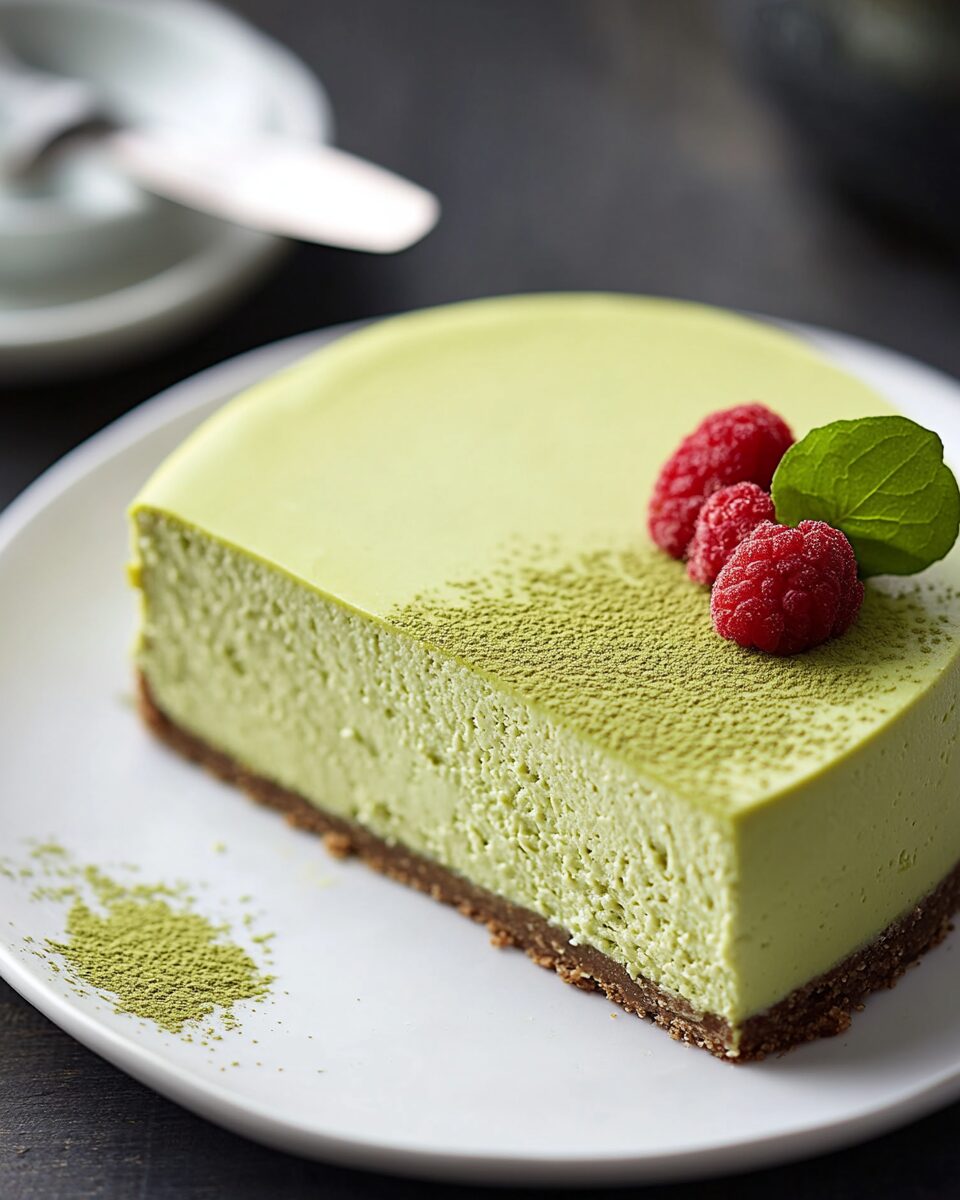Indulge in the harmonious blend of creamy cheesecake and the earthy essence of matcha with this Original Matcha Japanese Cheesecake. Perfect for those seeking a refined twist on the classic cheesecake, this recipe is a delightful fusion of traditional Japanese ingredients and Western baking techniques.
FULL RECIPE:
Ingredients
- 200g cream cheese, softened
- 60g unsalted butter
- 100ml whole milk
- 6 large eggs, separated
- 100g granulated sugar
- 1 teaspoon vanilla extract
- 70g cake flour
- 30g cornstarch
- 1/4 teaspoon salt
- 2 tablespoons high-quality matcha powder
Directions
- Prepare and Preheat: Preheat your oven to 320°F (160°C). Line the base and sides of an 8-inch (20cm) round cake pan with parchment paper.
- Matcha Infusion: In a small bowl, whisk the matcha powder with a splash of hot water until a smooth paste forms. Set aside to cool.
- Melt and Blend: In a double boiler, melt the cream cheese, butter, and milk together until smooth. Allow the mixture to cool slightly.
- Egg Yolk Harmony: Whisk the egg yolks and half of the sugar until pale and fluffy. Add the vanilla extract and the melted cream cheese mixture, incorporating the matcha paste for a vibrant green hue.
- Flour Fusion: Sift in the cake flour, cornstarch, and salt. Gently fold the dry ingredients into the matcha-infused batter until just combined.
- Whipped Brilliance: In a separate bowl, whip the egg whites until foamy. Gradually add the remaining sugar and continue whipping until stiff peaks form. Carefully fold the whipped egg whites into the batter in three additions, ensuring a light and airy texture.
- Bake to Brilliance: Pour the batter into the prepared pan and tap it on the counter to release any air bubbles. Place the cake pan in a larger baking dish filled with hot water (water bath) and bake in the preheated oven for 60-70 minutes, or until the top is golden and the center is set.
- Cooling Masterpiece: Allow the Matcha Japanese Cheesecake to cool in the oven with the door slightly ajar to prevent sudden temperature changes, which can cause cracking. Once cooled, refrigerate for a few hours or overnight before serving to enhance the flavor and texture.
Nutrition Facts
- Calories: 280 kcal
-
Total Fat: 18g
- Saturated Fat: 10g
- Cholesterol: 135mg
- Sodium: 120mg
-
Total Carbohydrates: 24g
- Dietary Fiber: 1g
- Sugars: 16g
- Protein: 7g
- Calcium: 90mg
- Iron: 1mg
The Unique Appeal of Matcha Japanese Cheesecake
Matcha Japanese Cheesecake is a delightful fusion of Japanese and Western dessert traditions. Unlike classic Western-style cheesecakes that are rich, dense, and often heavy, this Japanese version is incredibly light, fluffy, and airy. What sets this cheesecake apart is its soufflé-like texture, achieved through the careful incorporation of whipped egg whites. The addition of matcha not only enhances the flavor but also infuses the cake with a vibrant green color and health benefits. This cheesecake is perfect for those who appreciate a dessert that is not overly sweet yet still indulgent. The slight bitterness of matcha perfectly balances the subtle sweetness of the cheesecake, creating a sophisticated treat that appeals to both matcha enthusiasts and those new to Japanese flavors.
The Role of Matcha in Baking
Matcha, a finely ground green tea powder, has been a staple in Japanese culture for centuries. Traditionally used in tea ceremonies, matcha has now found its way into various culinary applications, particularly in baking. When added to desserts, matcha not only provides an earthy and slightly bitter flavor but also enhances the visual appeal of baked goods with its striking green hue. The quality of matcha significantly affects the taste of the cheesecake. High-quality ceremonial-grade matcha imparts a vibrant green color and a smooth, umami-rich taste, while lower-quality culinary matcha may be more bitter and dull in appearance. Selecting the right matcha ensures that the cheesecake has a balanced flavor without being overpoweringly bitter.
Baking Techniques for a Perfectly Airy Texture
One of the key features of a Japanese cheesecake is its delicate, cloud-like texture. Achieving this requires mastering a few essential baking techniques:
- Whipping Egg Whites to Perfection: The meringue is crucial in giving the cheesecake its airy structure. Beating the egg whites to stiff peaks and gently folding them into the batter ensures the cake rises beautifully.
- Water Bath Baking Method: This cheesecake is baked using a water bath (bain-marie), which provides gentle, even heat distribution. This prevents the cake from cracking and helps maintain its soft texture.
- Proper Cooling to Avoid Shrinking: Sudden temperature changes can cause the cake to deflate. To prevent this, the cheesecake should cool gradually inside the oven before being transferred to room temperature.
Health Benefits of Matcha Japanese Cheesecake
While cheesecake is often considered an indulgence, incorporating matcha adds a nutritional boost. Matcha is rich in antioxidants, particularly catechins, which have been linked to various health benefits, including improved metabolism and enhanced cognitive function.
Pairing Suggestions for Matcha Japanese Cheesecake
To elevate the experience of enjoying this cheesecake, consider pairing it with complementary flavors and beverages:
- Green Tea or Matcha Latte: Enhance the matcha flavor by pairing the cheesecake with a cup of hot green tea or a creamy matcha latte.
- Fresh Fruits: Serve with fresh berries, such as strawberries or raspberries, to add a touch of natural sweetness and acidity.
- Whipped Cream or Ice Cream: A dollop of lightly sweetened whipped cream or a scoop of vanilla ice cream can add a luscious contrast to the light texture of the cheesecake.
- Dark Chocolate Drizzle: A drizzle of dark chocolate sauce can provide a delightful contrast to the slightly bitter matcha notes.
Common Mistakes to Avoid
While Matcha Japanese Cheesecake is a rewarding dessert to make, a few common mistakes can affect the final result:
- Overmixing the Batter: Overmixing can deflate the whipped egg whites, leading to a dense and heavy cheesecake.
- Using Low-Quality Matcha: Inferior matcha results in a bitter, dull-colored cheesecake.
- Baking Without a Water Bath: Skipping the water bath can cause the cheesecake to crack and become dry.
- Rushing the Cooling Process: Removing the cake from the oven too soon can cause it to shrink and lose its fluffiness.
Conclusion
Matcha Japanese Cheesecake is a unique dessert that beautifully combines the rich traditions of Japanese and Western baking. Its light, airy texture and subtle matcha flavor make it a refreshing alternative to traditional cheesecakes. By using high-quality matcha, mastering the right baking techniques, and pairing it with complementary flavors, you can create a show-stopping dessert that is both delicious and visually stunning. Whether you’re a matcha lover or simply looking to try a new dessert, this cheesecake is a must-try treat that will impress any guest or satisfy your own sweet cravings.






